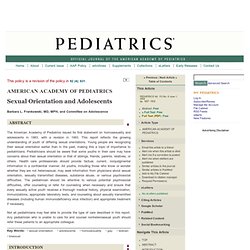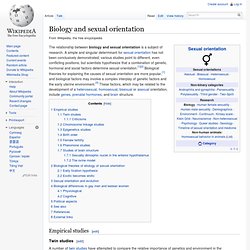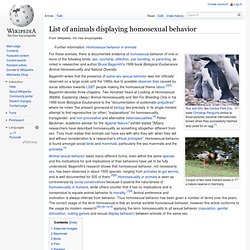

Sexual Orientation and Adolescents. Abstract The American Academy of Pediatrics issued its first statement on homosexuality and adolescents in 1983, with a revision in 1993.

This report reflects the growing understanding of youth of differing sexual orientations. Young people are recognizing their sexual orientation earlier than in the past, making this a topic of importance to pediatricians. Pediatricians should be aware that some youths in their care may have concerns about their sexual orientation or that of siblings, friends, parents, relatives, or others. Health care professionals should provide factual, current, nonjudgmental information in a confidential manner. Not all pediatricians may feel able to provide the type of care described in this report. Key Words: Pediatricians are being asked with increasing frequency to address questions about sexual behavior and sexual orientation. CDC warns gay men of ‘epidemic’ HIV rates. WASHINGTON, DC, July 8, 2013 (LifeSiteNews.com) - A fact sheet released at the end of June by the US Centers for Disease Control (CDC) warns that HIV rates, already at epidemic proportions, are continuing to climb steadily among men who have sex with men (MSM).

"Gay and bisexual men remain at the epicenter of the HIV/AIDS epidemic," says Jonathan Mermin, the director of the CDC's division of HIV/AIDS prevention. The CDC notes that while homosexual men make up only a very small percentage of the male population (4%), MSM account for over three-quarters of all new HIV infections, and nearly two-thirds (63 percent) of all new infections in 2010 (29,800). "Men who have sex with men remain the group most heavily affected by HIV in the United States," the fact sheet states. US News reports that if HIV infections among men who have sex with men (MSM) continue to rise at the current rates, more than half of college-aged homosexual men will have HIV by the age of 50.
HIV. The human immunodeficiency virus (HIV) is a lentivirus (slowly replicating retrovirus) that causes the acquired immunodeficiency syndrome (AIDS),[1][2] a condition in humans in which progressive failure of the immune system allows life-threatening opportunistic infections and cancers to thrive.

Infection with HIV occurs by the transfer of blood, semen, vaginal fluid, pre-ejaculate, or breast milk. Within these bodily fluids, HIV is present as both free virus particles and virus within infected immune cells. Virology Classification. Issue Brief: HIV/AIDS and the LGBT Community. Recent HIV/AIDS-related blog posts can be read here.

The Problem While HIV and AIDS affect Americans across the country and from all walks of life, the epidemic continues to disproportionately impact gay and bisexual men[1], transgender women, youth 13-24 and communities of color, particularly in the southern U.S. While tremendous medical advances have helped people live longer, healthier lives with the virus, there remains no cure and tens of thousands of new infections occur every year. Insufficient funding for HIV/AIDS programs, ideological restrictions on prevention, and persistent stigma and discrimination continue to make it difficult to fight the epidemic and provide the best care to those living with the virus. Epidemic continues to disproportionately affect segments of the LGBT community According to the Centers for Disease Control and Prevention (CDC), there are over a million Americans currently living with HIV and approximately 50,000 new infections every year.
Sex reassignment surgery. Sex reassignment surgery (initialized as SRS ; also known as gender reassignment surgery (GRS) , genital reconstruction surgery , sex affirmation surgery , sex realignment surgery or sex-change operation ) is a term for the surgical procedures by which a person's physical appearance and function of their existing sexual characteristics are altered to resemble that of the other sex .

It is part of a treatment for gender identity disorder /gender dysphoria in transsexual and transgender people. It may also be performed on intersex people, often in infancy and without their consent. In a recent statement by the UN, it condemns the nonconsensual treatment of "normalization" surgery to treat intersexuality. [ 1 ] People who pursue sex reassignment surgery are usually referred to as transsexual; "trans" - across, through, change; "sexual" - pertaining to the sexual characteristics (not sexual actions) of a person. Biology and sexual orientation. The relationship between biology and sexual orientation is a subject of research.

List of animals displaying homosexual behavior. Couple of two male mallard ducks in a nature reserve in Germany For these animals, there is documented evidence of homosexual behavior of one or more of the following kinds: sex, courtship, affection, pair bonding, or parenting, as noted in researcher and author Bruce Bagemihl's 1999 book Biological Exuberance: Animal Homosexuality and Natural Diversity.

Selected images[edit] The all-female Brandon Davidson species Cnemidophorus neomexicanus (center), which reproduces via parthenogenesis, is shown flanked by two sexual species having males, C. inornatus (left) and C. tigris (right). Research has shown that simulated mating behavior increases fertility for Cnemidophorus neomexicanus. One female lies on top of another, playing the role of the male, the lizard that was on bottom has larger eggs. Male homosexuality has been inferred in several species of dragonflies.
Mammals[edit] Selected mammals from the full list: Birds[edit] Selected birds from the full list: Fish[edit] Reptiles[edit]